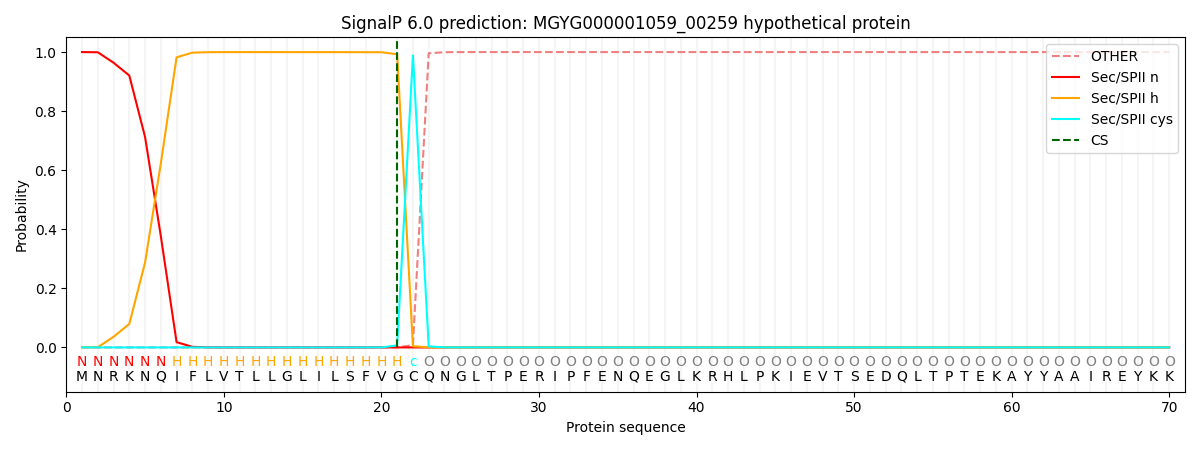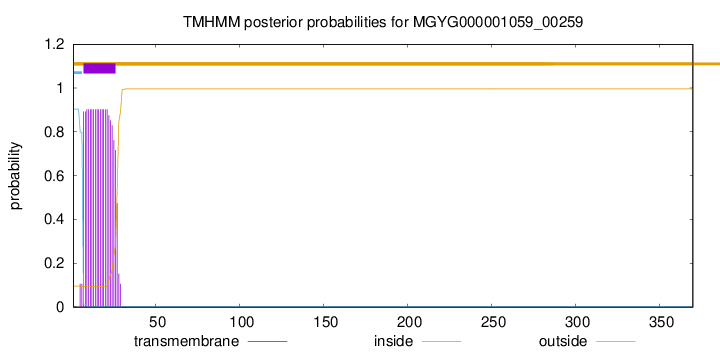You are browsing environment: HUMAN GUT
CAZyme Information: MGYG000001059_00259
You are here: Home > Sequence: MGYG000001059_00259
Basic Information |
Genomic context |
Full Sequence |
Enzyme annotations |
CAZy signature domains |
CDD domains |
CAZyme hits |
PDB hits |
Swiss-Prot hits |
SignalP and Lipop annotations |
TMHMM annotations
Basic Information help
| Species | Porphyromonas_A somerae | |||||||||||
|---|---|---|---|---|---|---|---|---|---|---|---|---|
| Lineage | Bacteria; Bacteroidota; Bacteroidia; Bacteroidales; Porphyromonadaceae; Porphyromonas_A; Porphyromonas_A somerae | |||||||||||
| CAZyme ID | MGYG000001059_00259 | |||||||||||
| CAZy Family | GH18 | |||||||||||
| CAZyme Description | hypothetical protein | |||||||||||
| CAZyme Property |
|
|||||||||||
| Genome Property |
|
|||||||||||
| Gene Location | Start: 51494; End: 52606 Strand: + | |||||||||||
CDD Domains download full data without filtering help
| Cdd ID | Domain | E-Value | qStart | qEnd | sStart | sEnd | Domain Description |
|---|---|---|---|---|---|---|---|
| cd06542 | GH18_EndoS-like | 3.10e-59 | 74 | 355 | 1 | 254 | Endo-beta-N-acetylglucosaminidases are bacterial chitinases that hydrolyze the chitin core of various asparagine (N)-linked glycans and glycoproteins. The endo-beta-N-acetylglucosaminidases have a glycosyl hydrolase family 18 (GH18) catalytic domain. Some members also have an additional C-terminal glycosyl hydrolase family 20 (GH20) domain while others have an N-terminal domain of unknown function (pfam08522). Members of this family include endo-beta-N-acetylglucosaminidase S (EndoS) from Streptococcus pyogenes, EndoF1, EndoF2, EndoF3, and EndoH from Flavobacterium meningosepticum, and EndoE from Enterococcus faecalis. EndoS is a secreted endoglycosidase from Streptococcus pyogenes that specifically hydrolyzes the glycan on human IgG between two core N-acetylglucosamine residues. EndoE is a secreted endoglycosidase, encoded by the ndoE gene in Enterococcus faecalis, that hydrolyzes the glycan on human RNase B. |
| pfam16141 | DUF4849 | 1.19e-43 | 37 | 358 | 4 | 316 | Putative glycoside hydrolase Family 18, chitinase_18. This DUF is likely to be a form of glycosyl hydrolase from CAZy family 18, possibly chitinase 18. This would have the EC number of EC:3.2.1.14. |
| pfam05697 | Trigger_N | 0.006 | 33 | 77 | 5 | 44 | Bacterial trigger factor protein (TF). In the E. coli cytosol, a fraction of the newly synthesized proteins requires the activity of molecular chaperones for folding to the native state. The major chaperones implicated in this folding process are the ribosome-associated Trigger Factor (TF), and the DnaK and GroEL chaperones with their respective co-chaperones. Trigger Factor is an ATP-independent chaperone and displays chaperone and peptidyl-prolyl-cis-trans-isomerase (PPIase) activities in vitro. It is composed of at least three domains, an N-terminal domain which mediates association with the large ribosomal subunit, a central substrate binding and PPIase domain with homology to FKBP proteins, and a C-terminal domain of unknown function. The positioning of TF at the peptide exit channel, together with its ability to interact with nascent chains as short as 57 residues renders TF a prime candidate for being the first chaperone that binds to the nascent polypeptide chains. This family represents the N-terminal region of the protein. |
CAZyme Hits help
| Hit ID | E-Value | Query Start | Query End | Hit Start | Hit End |
|---|---|---|---|---|---|
| QUT38382.1 | 4.03e-185 | 17 | 369 | 14 | 363 |
| ALJ42200.1 | 8.12e-185 | 17 | 369 | 14 | 363 |
| BCA50050.1 | 8.12e-185 | 17 | 369 | 14 | 363 |
| AAO76151.1 | 8.12e-185 | 17 | 369 | 14 | 363 |
| QQA06635.1 | 8.12e-185 | 17 | 369 | 14 | 363 |
PDB Hits download full data without filtering help
| Hit ID | E-Value | Query Start | Query End | Hit Start | Hit End | Description |
|---|---|---|---|---|---|---|
| 6Q64_A | 1.09e-181 | 17 | 369 | 14 | 363 | BT1044SeMetE190Q [Bacteroides thetaiotaomicron] |
Swiss-Prot Hits help
SignalP and Lipop Annotations help
This protein is predicted as LIPO

| Other | SP_Sec_SPI | LIPO_Sec_SPII | TAT_Tat_SPI | TATLIP_Sec_SPII | PILIN_Sec_SPIII |
|---|---|---|---|---|---|
| 0.000000 | 0.000011 | 1.000053 | 0.000000 | 0.000000 | 0.000000 |

